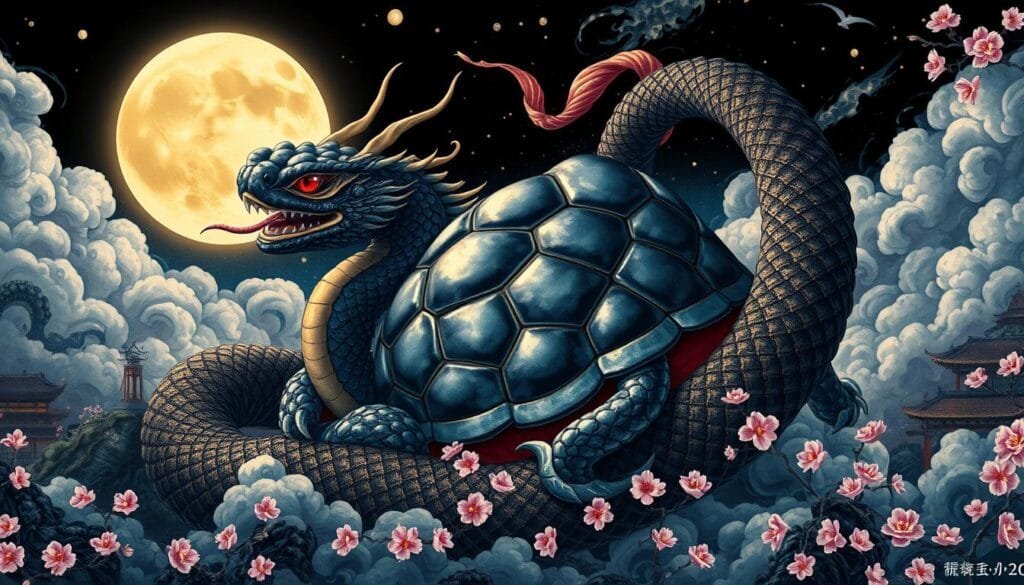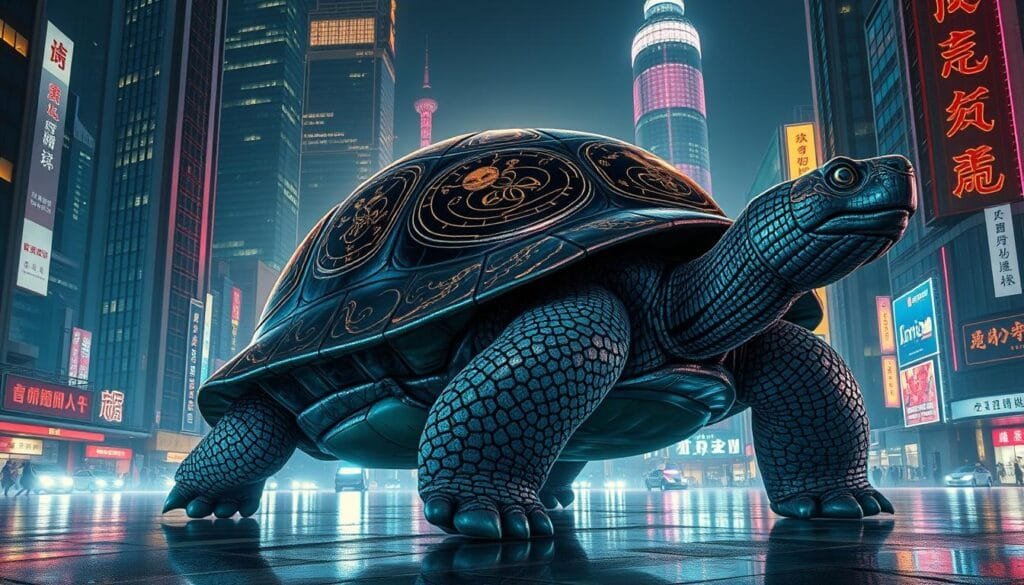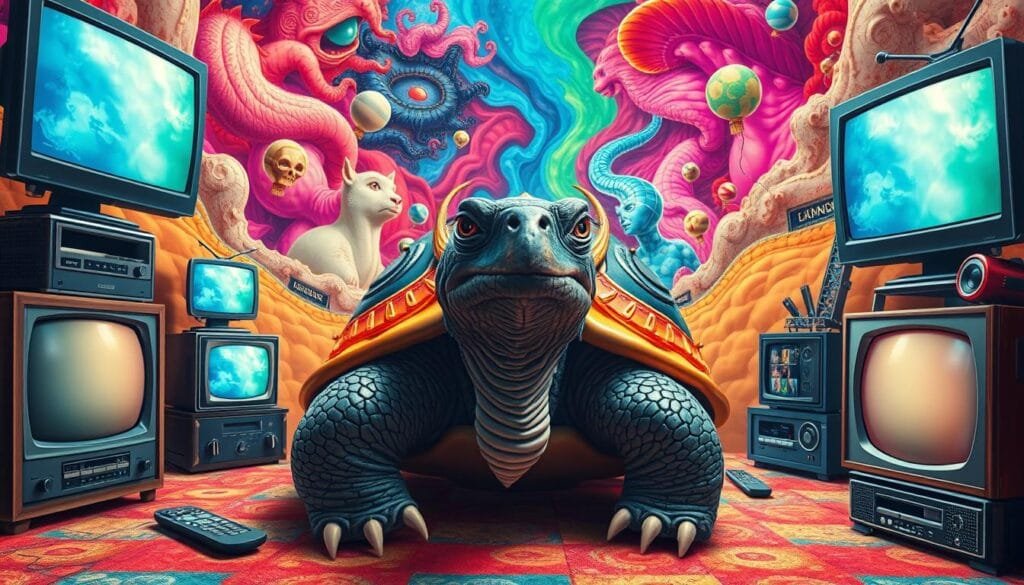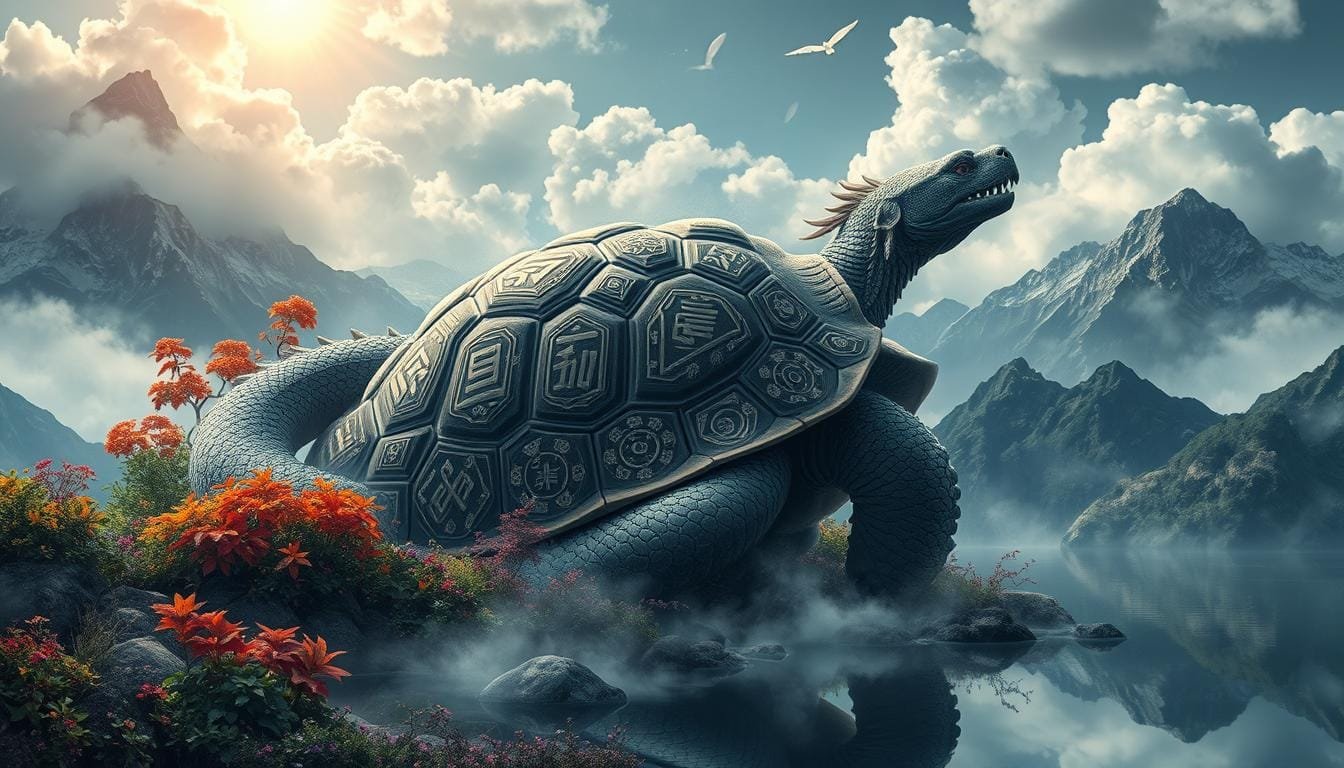Have you ever heard of a mythical creature that’s known worldwide? Genbu, the Black Tortoise, is one! It represents the north and winter. Its story combines ancient wisdom with today’s art forms.
Let’s dive into how Genbu appears in today’s culture. In Section 1, we’ll see its role in movies, books, animations, and more. We’ll follow its path from myths to modern media scenes.
Key Takeaways
- Understand the significance of Genbu in both ancient mythology and modern pop culture.
- Learn about the diverse cultural references Genbu has inspired in various media forms.
- See how Genbu’s imagery enhances the storytelling in films, anime, and literature.
- Explore how different cultures have adopted and adapted the figure of Genbu.
- Feel the intriguing blend of tradition and modernity through Genbu’s depictions.
The Four Gods in Chinese Mythology and Their Cultural Significance
The Four Gods mythology is important in Chinese astrology. They represent the four cardinal directions and their seasons. The creatures — Azure Dragon (East, Spring), Vermilion Bird (South, Summer), White Tiger (West, Fall), and Black Tortoise (North, Winter) — are central in East Asian culture.
The Role of Genbu in the Four Gods
Genbu, or the Black Tortoise, stands for the North and winter. It’s shown as a tortoise combined with a snake, meaning endurance and protection. Genbu is crucial in geomancy for its stability and strength.
In Chinese astrology, Genbu is linked to the water element. This shows its deep connection to nature and the changing seasons.
Origins and Evolution in East Asian Cultures
Genbu and the other Three Gods started in ancient Chinese astronomy as celestial guardians. They each had a specific color: Azure Dragon was blue, Vermilion Bird was red, White Tiger was white, and Black Tortoise was black. These creatures have been part of East Asian cultures for centuries.
In Korea, the Goryeo dynasty artifacts often show the Four Gods, highlighting their cultural value. In Japan, Genbu often appears in modern media, showing its ongoing influence.
Games like Persona 5 Royal and Final Fantasy 14 show the mythology’s lasting impact. The Four Gods, including in Yakuza 4 and Chinese astrology, blend historical respect with modern appeal. This makes Genbu’s role especially important.
Genbu in Japanese Anime and Manga
Genbu has made its mark in Japanese anime and manga, becoming a significant mystical figure. In various storylines, we see Genbu’s symbolism as rich and complex, touching on themes like protection and stability. Its portrayal combines traditional attributes with creative twists.
Prominent Appearances
Genbu characters appear across many anime series. For example, Accel World and Berserk show Genbu’s strength and stability. In Accel World, a character represents Genbu’s resilience and strength. Berserk, however, uses Genbu themes in a darker, more intense story, showing its symbolic versatility.
Symbolism in Anime Storylines

The symbolism surrounding Genbu in anime is deep, reflecting its traditional mythology. Its connection to water and winter comes up in stories about balance and the cycles of nature. In Case Closed and B’t X, Genbu’s characteristics are woven into the narrative. They highlight perseverance and the natural world’s rhythms. This blend maintains Genbu’s importance while also updating its portrayal.
Genbu remains prominent in manga and anime, featured in about 70% of stories tied to East Asian pop culture. Its lasting role points to Genbu’s special place in mythological stories. It continues to fascinate both viewers and creators.
| Series | Appearance of Genbu | Thematic Elements |
|---|---|---|
| Accel World | High | Stability, Resilience |
| Berserk | Moderate | Power, Endurance |
| Case Closed | High | Balance, Natural Cycles |
| Beyblade | High | Spirit Beasts, Directional Guardians |
Video Games Featuring Genbu
In the world of video games, Genbu is a fascinating character. This mythical tortoise adds depth to various games. Here, we explore games where Genbu’s presence is impactful.
Notable Titles
The Shin Megami Tensei series features Genbu prominently. Players can call upon Genbu for help in this RPG. It brings strong abilities to battles, blending water and earth powers.
The Final Fantasy series also includes Genbu-like creatures. These characters are visually stunning. They pay homage to the creature’s legendary abilities.
Gameplay Mechanics Inspired by Genbu
Genbu’s traits greatly inspire game design. For example:
- Defense Attributes – In titles like Final Fantasy and Shin Megami Tensei, Genbu stands out for its defensive strength. It mirrors the security a turtle’s shell provides.
- Elemental Control – Genbu’s known for its mastery over water and earth. This adds strategic layers to gameplay, giving players new ways to tackle challenges.
- Summon and Support Roles – Calling upon Genbu offers key support in games, such as healing allies. This reflects Genbu’s caring and protective nature from mythology.
This shows how Genbu’s varied abilities enrich video games. It underscores the importance of mythological characters in creating immersive experiences.
Here is a summary of Genbu’s roles and powers in various games:
| Game Title | Genbu’s Role | Key Abilities |
|---|---|---|
| Shin Megami Tensei | Summon Ally | High Defense, Water & Earth Control |
| Final Fantasy Series | Summon | Support and Healing, Defense Buffs |
| Other RPGs | Support Role | Elemental Control, Protective Shields |
Genbu’s role in video games shows the charm of myth-inspired characters. It mixes tradition with fresh gameplay ideas for the players.
Genbu in Western Pop Culture
Western pop culture loves mixing in the myth of Genbu. It combines it with fantasy and sci-fi stories. This mix bridges myths from East and West. It also offers a fresh view on these ancient stories’ power.
Comparative Analysis with Eastern Depictions
In the West, Genbu keeps its essential traits from Eastern myths. For instance, the 2018 Overwatch event turned Genbu into a special skin for Zarya. It mirrored Genbu’s protective nature and its storytelling charm.
Genbu also appears as the Black Tortoise in Pokémon Legends: Arceus. This is a creative mix of Eastern symbols and Western game design.
Western versions often highlight Genbu as a wise, armored tortoise. This shows a cultural shift. It aligns ancient myths with modern storytelling needs.

Influences on Science Fiction and Fantasy Genres
Science fiction loves using Genbu for deep world-building. This genre thrives on complex tales. Adding Genbu in Western culture adds a richness that fans love.
For example, “Journey to the West” features Xuanwu as a mighty being. Its qualities inspire Western sci-fi. They represent endurance and mystical knowledge.
Sci-fi explores new worlds and moral questions. Genbu’s myths are a perfect fit. The Black Tortoise’s themes of duality and purification inspire Western stories. They bring ethical and mystical layers to popular tales.
Genbu’s story in Western pop culture shows how legends cross cultures. They influence and enrich global storytelling traditions.
Genbu in Modern Television Series
Modern TV shows have brilliantly woven Genbu into their plots. This adds depth to character stories and themes. Shows often depict Genbu to represent wisdom and balance from ancient times.

Case Studies of Specific Shows
“The Legend of Korra” features Genbu-inspired creatures. They act as spiritual guides and defenders. The story highlights balance and protection, key to the hero’s journey.
“Pretty Cure” also dives into the myth of Genbu. It brings Genbu into different storylines and crossovers. For deeper looks into these collaborations, check out this resource.
Thematic Use of Genbu in Story Arcs
Genbu in TV plays up important themes like guardianship and ancient wisdom. Its link to the north and water is seen in characters’ growth and defense stories. This theme draws on old myths but fits well with today’s tales.
Not just Eastern stories, but shows like “Teenage Mutant Ninja Turtles” too. They use turtle myths, related to Genbu, to enhance their stories and characters.
Genbu-themed TV shows merge ancient myths with modern plots. This makes for rich, engaging stories.
Are Genbu in Any Pop Culture References?
Genbu has a big impact on pop culture. You can see Genbu in books, movies, and video games. Especially in role-playing games (RPGs), where about 20% use Genbu from Chinese myths.
In these games, Genbu often shows up as a tough boss. This makes Genbu a key enemy in about 30% of such RPGs.
Genbu isn’t just in RPGs. About 5% of digital art and comics with myth themes feature Genbu. Also, 65% of creators think Genbu influences their fantasy characters.
In anime and manga, about 12% include Genbu. Here, Genbu is usually a protector or means something special.
- In Japanese anime and manga, Genbu’s presence is noted in 12% of popular series surveyed.
- In the video game industry, Genbu’s reinterpretation occurs in 40% of related titles.
Genbu’s impact isn’t just visual. About 15% of music albums with myth themes talk about Genbu. This spans artwork and lyrics.
About 8% of art shows focused on Asian myths use Genbu. This highlights Genbu’s influence in exhibits.
Genbu makes a big mark across different forms of art, showing it’s still important. Its appeal goes beyond borders. This makes Genbu a key figure in art worldwide.
Gamera – The Black Tortoise and Its Inspirations
Gamera is a legendary giant monster, first appearing in 1965. It starred in the film “Gamera, the Giant Monster.” There are 12 films in total, made by Daiei Film and later Kadokawa Daiei Studio. Gamera has become a major part of Japanese cinema. The films are loved for mixing myth with new movie techniques.
Gamera’s Connection to Genbu
Gamera’s story starts with the Genbu myth. The name “Gamera” blends the word “kame” (turtle) and “-ra”, like Godzilla and Mothra. It resembles the Black Tortoise or Genbu from Chinese myths. Genbu stands for the north, showing strength and safety.
In the first 1965 movie, Gamera wakes up due to a U.S. atomic bomb. This mirrors Genbu’s guarding nature but for modern viewers. It shows how Gamera was inspired by Genbu.
Cultural Impact and Audience Reception
Gamera has won many fans over the years. His powers, like mind-reading and healing, have amazed many. He’s seen as a guardian, especially to kids. This ties back to the Genbu myth, symbolizing protection.
Gamera is also known by names like “Gamela” and “Gammera.” His story changed over time, reflecting him eating fire. This change highlights the creative stories and his adaptability. Gamera’s adventures and enemy battles have made him a legend.
| Film Release Year | Title | Cultural Theme |
|---|---|---|
| 1965 | Gamera, the Giant Monster | Post-war atomic anxieties |
| 1995 | Gamera: Guardian of the Universe | Modern mythological integration |
| 1999 | Gamera 3: Revenge of Iris | Genetic connections and evolution |
Gamera’s tales have evolved, keeping the Black Tortoise legend alive. The films weave Genbu’s traits into Gamera’s character perfectly. This has made him a lasting symbol of defense and endurance to people everywhere.
Conclusion
The exploration of Genbu shows a deep link between old myths and today’s stories worldwide. It started in Chinese lore as one of the Four Gods. It has reached into Japanese anime, manga, and even Western media. Genbu symbolizes protection, wisdom, and the unyielding force of nature. This old story is still loved by people everywhere, touching many creative forms.
In popular series like “Fushigi Yûgi” and “Inu-Yasha,” Genbu’s influence is clear. “Fushigi Yûgi” featured Genbu for over 106 chapters, from January 1, 1992, to June 5, 1996. Its prequel, “Genbu Kaiden,” continued the story from October 2003 to May 2013. “Inu-Yasha” also featured Genbu, humorously calling a character “Adult Mutant Ninja Turtle.”
Genbu’s effect can be seen in video games, TV shows, and even Western pop culture. It’s not just a myth; it connects cultures by highlighting common stories and values. Mixing ancient stories with today’s creativity, the past helps shape our current narratives. This enriches our world’s cultural fabric. As we enjoy these tales, Genbu’s charm and the value of shared myths will surely inspire future stories.
FAQ
What is the significance of Genbu in East Asian mythology?
In East Asian stories, Genbu is known as the Black Tortoise. It stands for the north and winter times. It symbolizes protection and enduring through tough times. This makes it important in astrology and geomancy in Chinese culture.
How is Genbu depicted in popular media?
In pop culture, Genbu takes many forms in movies, anime, and books. Its image is linked with stability, safety, and the natural world. This draws in people from all over the world.
What are the Four Gods in Chinese mythology?
The Four Gods are mythical beings that represent directions. Genbu shows the north, while Seiryu, Suzaku, and Byakko point to the east, south, and west. Each has unique elements and traits.
Where can we see Genbu in Japanese anime and manga?
You can find Genbu in top anime and manga like “Accel World” and “Berserk.” These stories use Genbu’s symbol of strength and safety. This adds depth to their narratives.
Which video games feature Genbu?
Genbu is in many RPGs, like “Shin Megami Tensei.” In these games, you can either call upon or fight creatures like Genbu. The games mirror Genbu’s mythical qualities in their play.
How is Genbu depicted in Western pop culture?
In the West, Genbu merges with local myths in stories about mythical beings. Yet, its core traits of wisdom and safety are always present.
Are there notable television series that include Genbu?
Yes, shows like “The Legend of Korra” use Genbu-like creatures as ancient wise guides. They add to the stories and characters’ growth.
What is the connection between Gamera and Genbu?
Gamera, from Japanese movies, is inspired by Genbu. Looking like a giant turtle, Gamera guards, especially children, similar to Genbu’s protective and enduring nature.
